(捷进英语1)Unit7-电子教案
- 格式:doc
- 大小:65.50 KB
- 文档页数:5
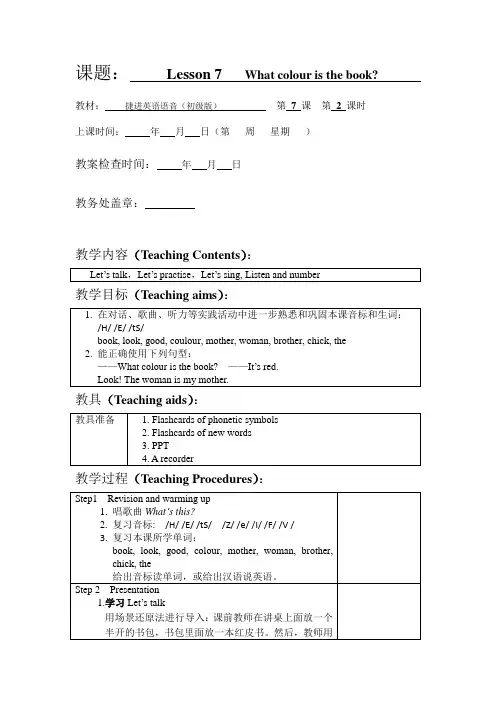
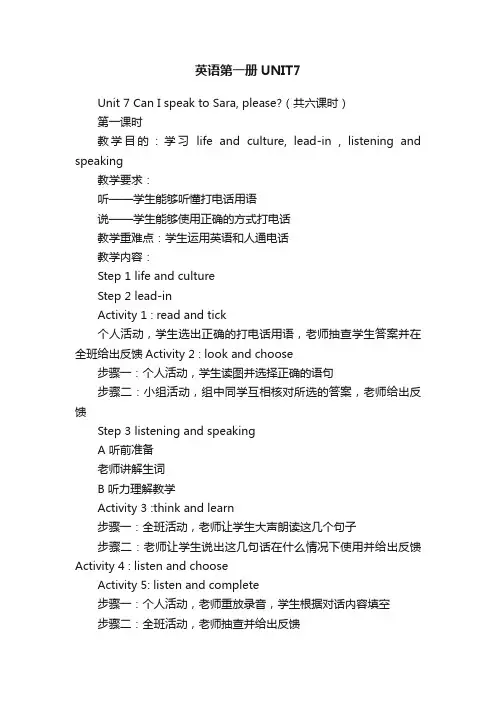
英语第一册UNIT7Unit 7 Can I speak to Sara, please?(共六课时)第一课时教学目的:学习life and culture, lead-in , listening and speaking教学要求:听——学生能够听懂打电话用语说——学生能够使用正确的方式打电话教学重难点:学生运用英语和人通电话教学内容:Step 1 life and cultureStep 2 lead-inActivity 1 : read and tick个人活动,学生选出正确的打电话用语,老师抽查学生答案并在全班给出反馈Activity 2 : look and choose步骤一:个人活动,学生读图并选择正确的语句步骤二:小组活动,组中同学互相核对所选的答案,老师给出反馈Step 3 listening and speakingA 听前准备老师讲解生词B 听力理解教学Activity 3 :think and learn步骤一:全班活动,老师让学生大声朗读这几个句子步骤二:老师让学生说出这几句话在什么情况下使用并给出反馈Activity 4 : listen and chooseActivity 5: listen and complete步骤一:个人活动,老师重放录音,学生根据对话内容填空步骤二:全班活动,老师抽查并给出反馈C 听力表达教学1)准备Activity 6:listen ,read and underline2)表达训练Activity 7: act and practiceActivity 8 : act and practice课堂小结:【注释】1、我是玛丽Speaking-----回答Can/May I speak to Mary?Mary speaking.This is Mary speaking.2、this我是 This is Jack.3、 that你是Who’s that? Is that Jack?4、hold on, please.请拿着话筒稍等5、Sara isn’t in at the moment.6、May I take a message?Unit 7 Can I speak to Sara, please?(共六课时)第二课时教学目的:学习完成part1 listening and speaking学案教学要求:掌握听力材料中的词汇和句型,以及听力过程中的推断技巧教学内容:Step 1英汉互译打电话和……说话打羽毛球打网球此刻稍候带个口信接听电话在五点告诉某人做某事Step 2 问题探究1、 Message和information*Message “消息,口信”可数名词Leave a message留口信take a message捎口信send a message送口信give a message给口信*Information“信息,消息”不可数名词A piece of information一条信息2、please祈使句(1)Please+动词原形/ 动词原形+pleaseEg: Please mail this letter for me.Fill up the form,please.(2)Please don’t+动词原形Eg: Please don’t smoke h ere.3、tell sb (not)to do sthEg: She told us not to play football on the street.课后小结:Unit 7 Can I speak to Sara, please?(共六课时)第三课时教学目的:学习reading and writing教学要求:读——学生能够读懂介绍正在进行的动作或行为的与体育有关的文章写——学生能够运用现在进行时态写出正确的句子教学重难点:学生能够将动词词组与名词词组进行正确的搭配教学内容:reading and writingA 阅读导入老师首先介绍本部分的主要活动及主要目的,即阅读有关体育的文章,正确理解文章中正在进行时的句子B 阅读准备Activity 9: look and match个人活动,学生读图,并将图和句子匹配,老师抽查并给出反馈C读写综合训练Activity 10: read and circle步骤一:个人活动,学生阅读邮件并圈出正在进行时的句子步骤二:全班活动,老师提问检查,并对文中的重点词汇和句型进行讲解Activity 11: read and judegActivity 12: read and write步骤一:全班活动,老师带领学生读图,了解每幅图的内容步骤二:小组活动,组员一起读文章,讨论写出适当的句子描述图片步骤三:全班活动,老师点名检查学生完成情况并给出反馈【注释】1、national football team国家足球队2、This match will be held next month in the Bird Nest Stadium.举行鸟巢体育馆3、Many of my classmates are working as volunteers.work as做……工作Eg: She is working as a nurse in a hospital.4、I’m placing flowers and putting up posters on the roads.place flowers摆放花卉5、Some are providing(提供) translation and other servicesprovide sb with sth provide sth (for sb )Eg: *Our parents provide us with food and clothing(衣食).*The hotel provides a shoe-cleaning service for its residents(旅客).*This course(课程)is free, but you have to provide your own books.6、Best Regards 诚挚的问候课后小结:Unit 7 Can I speak to Sara, please?(共六课时)第四课时教学目的:学习完成part 2 reading and writing学案教学要求:熟读课文,掌握主要信息,背诵典型句型教学内容:Step 1知识链接1、与work有关的词组Work for 为……工作Work in 在……工作Work with和……一起共事Work on从事、抓紧办理、致力于Eg:------Have you drawn up (拟出)that list of names yet?------No, but I’m working on it.2、与hand有关的词组Hand over移交,交给Eg: Mr. Wang handed over his work to me.Hand in上交,交出Hand out分发Hand up举手3、与put有关的词组Put away收拾,放妥Eg: Put away the tools after work, will you?Put off推迟Eg: They decided to put the meeting off until after Christmas.Put on上演,穿上Eg: He put on his best clothes for the party.Put up举起,张贴Eg: Please puit up your hand if you have any questions.Put down写下,记下Eg: Put down the phone number for me ,please.课后小结:Unit 7 Can I speak to Sara, please?(共六课时)第五课时教学目的:学习language in use, unit task, pronunciation practice教学要求:学生能够正确使用现在进行时态表达正在进行的动作,了解部分与体育相关的词汇教学重难点:完成单元任务——学生就最喜欢的明星做介绍教学内容:Step 1 language in useGrammar focus:A 呈现通过表格呈现给学生现在进行时态的特殊疑问句,一般疑问句以及回答,注意不同的人称和数的变化步骤一:个人活动,学生自己读表步骤二:个人活动,老师引导学生说出进行时态的特殊疑问句,一般疑问句以及回答变化规则B训练与应用Activity 13 : look and talk步骤一:全班活动,老师带领学生读图,明确图片中人物存在进行的动作步骤二:全班活动,老师与班上一位同学做对话示范,等角和特殊疑问句及其回答做对话步骤三:双人活动,学生两人一组做对话,老师抽查完成情况并给出反馈步骤四:全班活动,老师再与一名同学用一般疑问句做对话,然后学生两人一组对话。
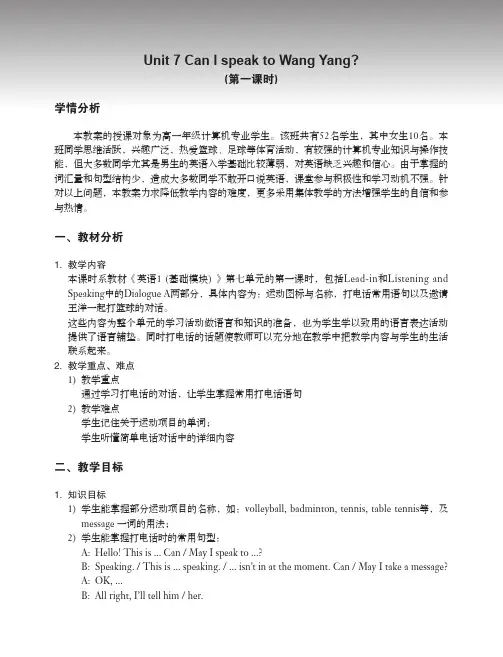
106英语1(基础模块)电子教案Unit 7 Can I speak to Wang Yang?(第一课时)学情分析本教案的授课对象为高一年级计算机专业学生。
该班共有52名学生,其中女生10名。
本班同学思维活跃,兴趣广泛,热爱篮球、足球等体育活动,有较强的计算机专业知识与操作技能,但大多数同学尤其是男生的英语入学基础比较薄弱,对英语缺乏兴趣和信心。
由于掌握的词汇量和句型结构少,造成大多数同学不敢开口说英语,课堂参与积极性和学习动机不强。
针对以上问题,本教案力求降低教学内容的难度,更多采用集体教学的方法增强学生的自信和参与热情。
一、教材分析1. 教学内容本课时系教材《英语1 (基础模块) 》第七单元的第一课时,包括Lead-in和Listening and Speaking中的Dialogue A两部分,具体内容为:运动图标与名称,打电话常用语句以及邀请王洋一起打篮球的对话。
这些内容为整个单元的学习活动做语言和知识的准备,也为学生学以致用的语言表达活动提供了语言铺垫。
同时打电话的话题使教师可以充分地在教学中把教学内容与学生的生活联系起来。
2. 教学重点、难点1) 教学重点通过学习打电话的对话,让学生掌握常用打电话语句2) 教学难点学生记住关于运动项目的单词;学生听懂简单电话对话中的详细内容二、教学目标1. 知识目标1) 学生能掌握部分运动项目的名称,如:volleyball, badminton, tennis, table tennis等,及message 一词的用法;2) 学生能掌握打电话时的常用句型:A: Hello! This is ... Can / May I speak to ...?B: Speaking. / This is ... speaking. / ... isn’t in at the moment. Can / May I take a message?A: OK, ...B: All right, I’ll tell him / her.107A: Thank you. Bye!2. 能力目标1) 学生能听懂关于打电话邀请别人参加某一体育活动的对话;2) 学生能根据常用打电话句型,打电话邀请别人参加某一体育活动。
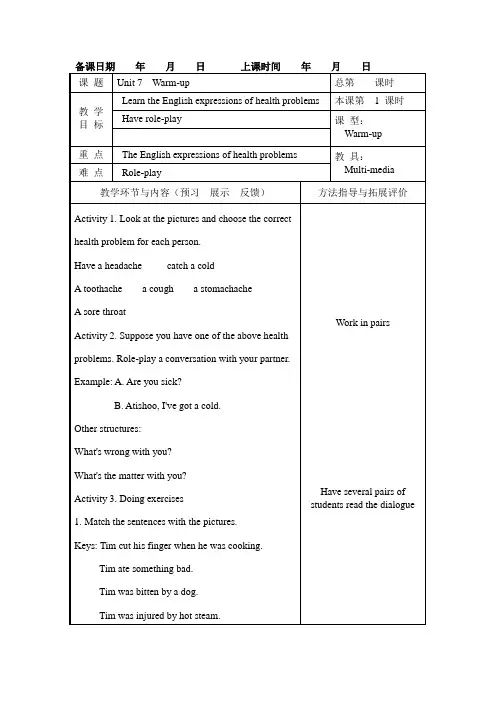
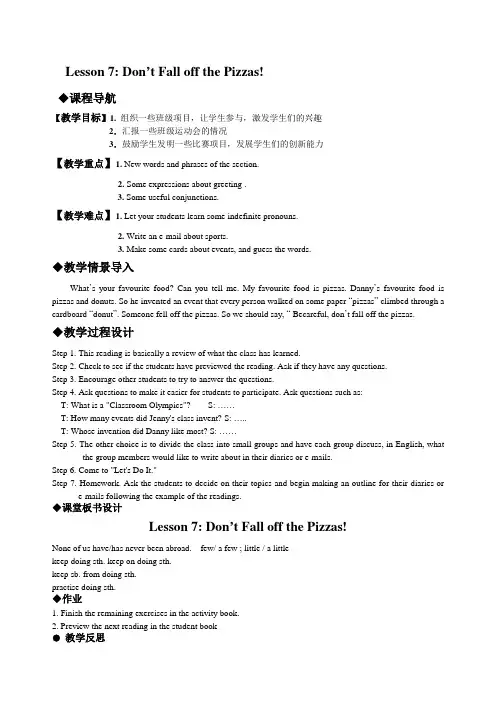
Lesson 7: Don’t Fall off the Pizzas!◆课程导航【教学目标】1. 组织一些班级项目,让学生参与,激发学生们的兴趣2.汇报一些班级运动会的情况3.鼓励学生发明一些比赛项目,发展学生们的创新能力【教学重点】1. New words and phrases of the section.2. Some expressions about greeting .3. Some useful conjunctions.【教学难点】1. Let your students learn some indefinite pronouns.2. Write an e-mail about sports.3. Make some cards about events, and guess the words.◆教学情景导入What’s your favourite food? Can you tell me. My favourite food is pizzas. Danny’s favourite food is pizzas and donuts. So he invented an event that every person walked on some paper “pizzas” climbed through a cardboard “donut”. Someone fell off the pizzas. So we should say, “ Becareful, don’t fall off the pizzas.◆教学过程设计Step 1. This reading is basically a review of what the class has learned.Step 2. Check to see if the students have previewed the reading. Ask if they have any questions.Step 3. Encourage other students to try to answer the questions.Step 4. Ask questions to make it easier for students to participate. Ask questions such as:T: What is a "Classroom Olympics"? S: ……T: How many events did Jenny's class invent? S: …..T: Whose invention did Danny like most? S: ……Step 5. The other choice is to divide the class into small groups and have each group discuss, in English, what the group members would like to write about in their diaries or e-mails.Step 6. Come to "Let's Do It."Step 7. Homework. Ask the students to decide on their topics and begin making an outline for their diaries or e-mails following the example of the readings.◆课堂板书设计Lesson 7: Don’t Fall off the Pizzas!None of us have/has never been abroad. few/ a few ; little / a littlekeep doing sth. keep on doing sth.keep sb. from doing sth.practise doing sth.◆作业1. Finish the remaining exercises in the activity book.2. Preview the next reading in the student book●教学反思英语对于现在的学生来说,是一门比较难学的学科。

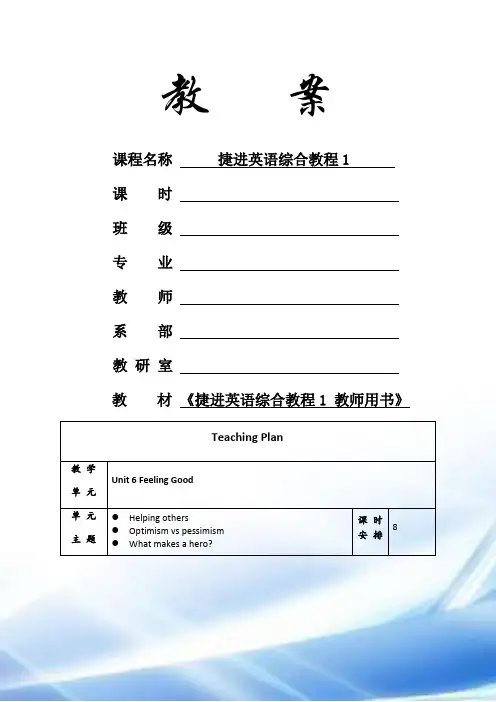
教案课程名称捷进英语综合教程1课时班级专业教师系部教研室教材《捷进英语综合教程1 教师用书》Teaching Plan教学单元Unit 6 Feeling Good单元主题●Helping others●Optimism vs pessimism●What makes a hero?课时安排8教学内容●Reading for learningWould You Like to Make a Difference?●Reading for DoingHalf Full or Half Empty?●Guided WritingA Letter of Thanks●Audio/Video Lab教学环节主要特色教学活动安排建议Warm-up(热身)This section introducesthe idea of feelings andreactions. It does thisthrough a set ofadjectives and musicclips for students toreact to.✧Depending on the time you have available,you could extend this into students playingtheir own music and discussing how themusic makes them feel.Reading (阅读)Readingforlearning◆This section startswith usingpronoun referentswhen reading tohelp understandthe organisation ofa text. It thenencouragesstudents to workout reasons in thetext.◆Vocabulary andGrammarStudents look atphrases and individualwords from the text.The grammar focus✧In Task 4 of Reading and Understanding,you could ask students to compare theirtranslations with a partner. Then ask studentsto close their books and translate them backinto English.✧In Vocabulary Focus, the three vocabularytasks draw on the text. Task 1 and Task 3 arealso a set of questions and so work well aspair-work discussion tasks.✧The Grammar Focus part looks at differentways of referring to the past, present andfuture with quite simple structures. Afterworking through the tasks you would setstudents a short written or spoken task usingthese structures to refer to their own desiresin the past present and future.✧Beyond the Text encourages students to reactlooks at would like to, like to and wanted to.◆Beyond the TextStudents interpret their own decisions. personally to the texts they have read. It also practices the grammar structure. Students could also think about and discuss their own good deeds.Reading for doing ◆Students read andanswer aquestionnaire onoptimism andpessimism.✧This section should take less time thansection A as the text is less complicated.They focus on developing students’ everydayreading skills as they are reading andresponding to a questionnaire.✧If time permits, students could create theirown scenario and options for others tochoose as an additional question in thequestionnaire.Guided Writing ◆Writing a letter ofthanks:(1) Formal expressionsof thanks(2) Informalexpressions ofthanks ✧When checking Task, 2 you could highlightsome of the other features of informality aswell as the vocabulary / phrases focused on,e.g. the punctuation and contractions.✧With weaker students you might want toshow them the model first before they writetheir email.Audio/Video Lab ◆Students watch avideo showingan interviewwith someonewho has donesomethingheroic:(1) making predictions(2) dictating andansweringquestions ✧Write hero onto the board and ask students todefine the word and to think of an example of one.✧When you get to Task 5, you will probablyneed to pause briefly between each question.Wrap-up ◆This sectionprovides a quickreview of thevocabulary,grammar, writing ✧For Task 1, Task 2 and Task 3 on thelanguage work, you might want to set themup as a team game or class quiz.✧For Task 4, it could be set as small groupand theme of theunit.◆Tasks could be setfor individualwork or done inpairs.discussion task.课后学习设计作业◆Finish all the exercises in Unit 6.◆Read the two texts in this unit again and try to summarisetheir contents.◆Write a letter of thanks to a person who ever helped you.课后总结和反思。
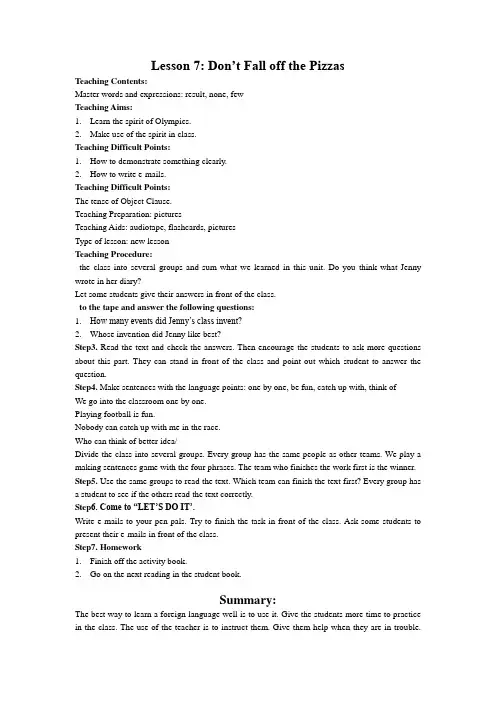
Lesson 7: Don’t Fall off the PizzasTeaching Contents:Master words and expressions: result, none, fewTeaching Aims:1.Learn the spirit of Olympics.2.Make use of the spirit in class.Teaching Difficult Points:1.How to demonstrate something clearly.2.How to write e-mails.Teaching Difficult Points:The tense of Object Clause.Teaching Preparation: picturesTeaching Aids: audiotape, flashcards, picturesType of lesson: new lessonTeaching Procedure:the class into several groups and sum what we learned in this unit. Do you think what Jenny wrote in her diary?Let some students give their answers in front of the class.to the tape and answer the following questions:1.How many events did Jenny’s class invent?2.Whose invention did Jenny like best?Step3. Read the text and check the answers. Then encourage the students to ask more questions about this part. They can stand in front of the class and point out which student to answer the question.Step4. Make sentences with the language points: one by one, be fun, catch up with, think ofWe go into the classroom one by one.Playing football is fun.Nobody can catch up with me in the race.Who can think of better idea/Divide the class into several groups. Every group has the same people as other teams. We play a making sentences game with the four phrases. The team who finishes the work first is the winner. Step5. Use the same groups to read the text. Which team can finish the text first? Every group has a student to see if the others read the text correctly.Step6. Come to “LET’S DO IT’.Write e-mails to your pen pals. Try to finish the task in front of the class. Ask some students to present their e-mails in front of the class.Step7. Homework1.Finish off the activity book.2.Go on the next reading in the student book.Summary:The best way to learn a foreign language well is to use it. Give the students more time to practice in the class. The use of the teacher is to instruct them. Give them help when they are in trouble.Class is a large stage for the students to act.。
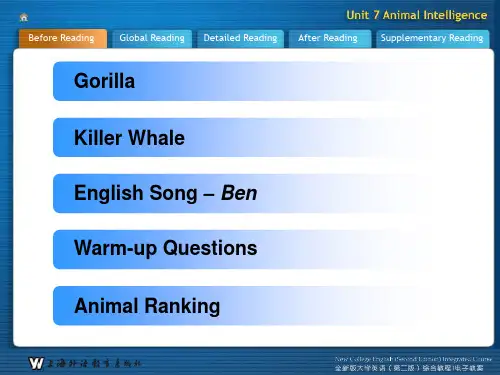
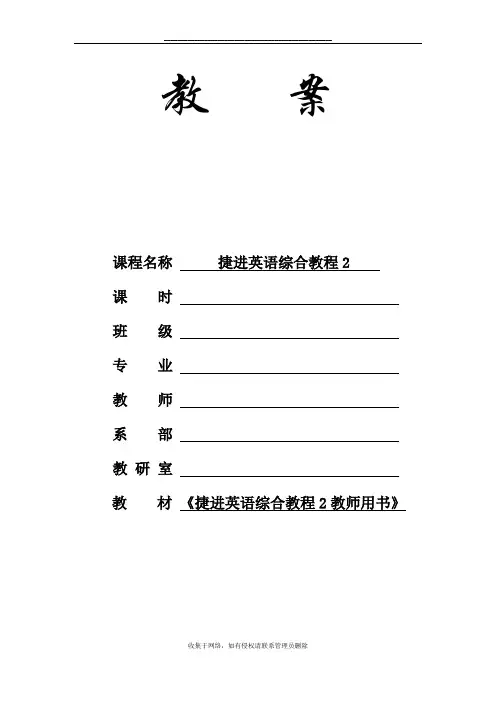
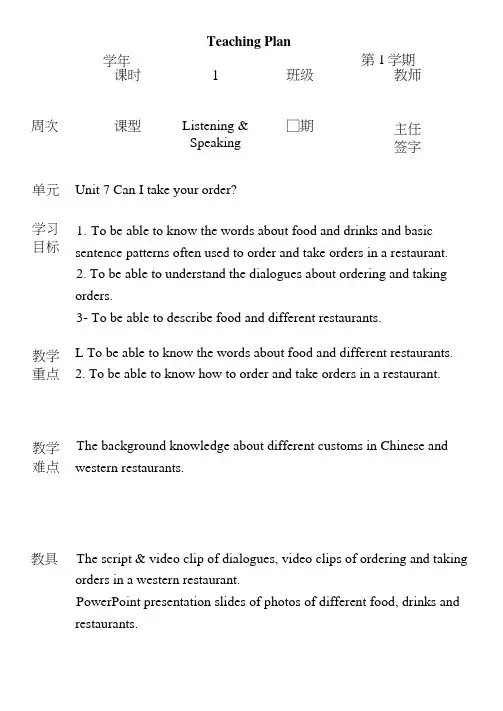
课时 1 班级 教师 周次课型 Listening & Speaking □期 主任 签字 单元Unit 7 Can I take your order? 学习目标1. To be able to know the words about food and drinks and basic sentence patterns often used to order and take orders in a restaurant.2. To be able to understand the dialogues about ordering and taking orders. 3- To be able to describe food and different restaurants. 教学重点L To be able to know the words about food and different restaurants. 2. To be able to know how to order and take orders in a restaurant. 教学难点The background knowledge about different customs in Chinese and western restaurants. 教具 The script & video clip of dialogues, video clips of ordering and takingorders in a western restaurant.PowerPoint presentation slides of photos of different food, drinks and restaurants. Teaching Plan学年 第1学期教学环节设计教学步骤教学过程设计教学环节设计WarmingupI・ Play a short video about having dinner in a restaurant.Ask students where they are and what they are doing・II.S how the students the picture on Page 69 of Unit 7, askthem to look at the picture and discuss:1.Where are they?2.What are they doing?III.Introduce the key themes to the students.IV.Ask the students to listen to the six sentences andmatch the words with the pictures in Activity ①,Warming up on Page 70・V.Ask the students to match the key words with thepictures in Activity ②.VL Present different restaurants and foods on slides andask students to match them quickly.Listening & Speaking practice (1) I.Present the photos and words in the word box on Page71. Then ask the students to read and understand them after the tape.II.Show the pictures of three different restaurants. Ask the students to choose the restaurant mentioned in the dialogue after listening・III.Present the basic sentences on the blackboard: Would you like to have dinner with me tonight? How about the Italian restaurant down the street?IV.Ask the students to read the dialogue after the tape.And then ask them to make dialogues in pairs with the given words in Activity ② on Page 71.V・ Ask some pairs to act out the dialogue in class, and invite others to comment.VI. Divide students into different groups to set up different restaurants. Ask them to name th&rrestaurants and the names of some special food ordishes- Stick the names on the blackboard and ask the students to act out the dialogues and choose theirfavourite dishes.Listening & Speaking practice (2) I- Present some photos of food and drinks on the slide, and ask the students to guess what are mentioned in the dialogue.II.A sk the students to listen to the dialogue on Page 72, and to find out what food and drinks are mentioned. III.Present the important sentences on the slide and explain the meaning :Can I take your order now?VPd like the vegetable soup to start with.What would you like for the main course?Would you like anything to drink?IV.Play a short video of eating out in a western restaurant, and introduce the customs of having western教学环节设计Consolidati on I- Divide the students into groups and ask them to sort the words presented on the slide into different parts: such as starters, main courses, drinks and desserts.II.A sk the students to take part in a group competition. And ask them to write as many words about food and drinks as they can on the blackboard.III.Group discussion・ The different table manners between the Chinese people and Western people.Summary Key words and phrases:dinner order drink starter dessertvegetable soup main course western restaurant Keysentence patterns:Can I take your order?What would you like for the main course?Fd like vegetable soup to start with・Homework 1.Ask the students to read the dialogues.2.Ask the students to memorise the key words, phrasesand sentence patterns.3.Ask the students to collect information about customsat table in different countries.。
冋- 2 F H「F g g n • 1 ^*5 • 口F n主任签字习标学目gof怡匸adng1 dur p eono i 山thtlcnses andm tPC n acoownt • 1「教学重点• •s e ・ai te rat str ng dies.5 S a教学环节设计骤步教Teaching Plan学年第1学期教学环节设计WarmingupI. Ask the students to discuss what food or drinks theylike, and ask some students to give answers.IL Introduce the learning content to the students: They aregoing to read further information about different dietsaround the world.Pre-reading I.Present some new words and photos in the menu onPage 73. Tell the students their meanings andpronunciations.II.A sk the students to discuss the following phrases andtell which of them belong to a Western menu andwhich to a Chinese menu: hot dishes, main courses,starters, cold dishes.Readingpractice (1)I.Ask the students to skim the passage in Activity ① onPage 73, and try to make an order for themselves.Remind them of the order of making orders.II.A sk the students to answer some questions thatappeared in the previous lesson:What would you like for...?rd like..., please.IIL Ask the students to read the menu in Activity ②,and invite some students to play the roles of a customeror a waiter using the menu.IV. Explain the cultural difference between Chinese andWestern restaurants.Reading practice (2) I- Present the photos of three different restaurants, and ask the students to discuss which one they like best.II.A sk the students to read the passage on Page 74, and then match the names of the restaurants with their special dishes.III.Ask the students to read after the tape and underline the important words and phrases. Explain their meanings to them.If you like you should visit...It is famous for...For... lovers, ... would give them a great treat.IV.Ask the students to read again and work in pairs to find a suitable restaurant for the people in Activity ④on Page 74.教学环节设计Readingpractice (3)I.Present the images of different people working in arestaurant. Ask the students to try to match the imageswith the words.II.P resent the answers. Explain the meaning of the wordsand supply relative background knowledge.III.Ask the students to read the sentences in Activity ⑥in pairs, and then discuss the job expressed in eachsentence.IV.Present the correct answer. Ask some students to actthese different roles by using body language or simplewords, others may guess what job it is.Consolidati on I.Divide the students into different groups. Every group works for a restaurant in the world. Ask them to make a menu for their restaurant.II.I nstruct the students to play a role in their restaurant and ask them to write down their work in their restaurant.III.Encourage some students to introduce their work in class.Summary Key words and phrases:menu treat managerchef barman roast beefKey sentence patterns:If you like …,you should visit...It is famous for ...For... lovers,... would give them a great treat.Homework 1.Ask the students to memorize the key words, phrases and sentence patterns.2.Ask the students to complete their restaurant menu andpost them on the wall.3.Ask the students to preview "Around the World',onPage 77 and look up the new words in dictionaries.。
捷进英语Unit 7老猴子咬菜根学习交流Lesson 1 Nu La's interview Nu La的面试1.Good morning... 早上好……Nu La? 你是Nu La吗?Yes. 是的。
Hello. 您好。
Please sit down. 请坐。
Thank you. 谢谢!You're interested in a job here? 你对在这儿工作感兴趣?As housekeeping Manager? 想应征客房部经理?Yes, thank you. 是的,谢谢。
2.Where are you from, Nu La? Nu La,请问你是哪国人?I come from Cambodia. 我是柬埔寨人。
I come from Phnom Penh. 来自金边。
When did you come to the United States? 你是什么时候来美国的?A year ago. 一年前。
3.Well, you speak good English. 嗯,你英语讲得不错。
Thank you. 谢谢!Did you come straight to Boston? 你是不是一到美国就来了波士顿?No,no,no. 不。
First San Francisco. 我先到了旧金山。
Then Denver. 然后去了丹佛。
Then Chattanooga, Tennessee. 后来又去了田纳西州的Chattanooga。
Now I live in Boston, Massachusetts. 现在我住在麻省的波士顿。
4.Well, we need someone with experience. 嗯,我们这份工作需要有经验的人。
What was your work in Phnom Penh? 你在金边有过什么工作经历。
The same! 相同的工作!Head housekeeper. 我曾作客房部领班。